|
|
review
|
It’s Up To You: The Practice of Self-Reflection on The Buddhist Path
Dzigar Kongtrul
Shambhala, 2005
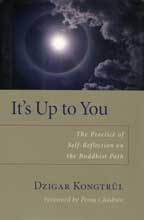 It’s up to you. These words still ring in my mind. In this book, Dzigar Kongtrul gives the tools to start a journey where you are the student as well as the teacher. Using our everyday experiences as a mirror, this book challenges us to learn more about who we are by asking questions such as: What is fact and what has my imagination created? It’s up to you. These words still ring in my mind. In this book, Dzigar Kongtrul gives the tools to start a journey where you are the student as well as the teacher. Using our everyday experiences as a mirror, this book challenges us to learn more about who we are by asking questions such as: What is fact and what has my imagination created?
Dzigar Kongtrul is a Buddhist teacher who was born in northern India and has been teaching in North America for a number of years. This shows in his writing, which is clear and straightforward, and allows my Western mind to see how to incorporate the practice of Buddhism into my everyday life.
Kongtrul teaches that our pain and suffering stem from our ‘Ego-mind’ and our attachment to self. He challenges us to search for this self, leading us to discover that we follow our Ego-mind all of our lives. He asks us to look at how this invisible Ego-mind or “ghost” has served us, suggesting that by treating it like a ghost and asking it to show its face, we can begin to loosen our attachment to it. This, he suggests, allows us to start on the path to freedom.
I took this book to heart and have been using this exercise to help in my daily self-reflection. I have learned that the only thing that stops me from being the person who I want to be is myself. As I’ve been sitting here writing this review my mind constantly goes to the past, a time when I would be sick to my stomach, even missing school, at the thought of having to express myself on paper. Feeling judged or criticized has held me down for a long time. I am truly my worst judge and critic.
However, now things are starting to shift, and I see how I have the power of choice. I have the power to choose whether I feel happy or sorrowful, angry or full of love. It is up to me, and no one can take this away from me. This book has been a blessing to me. Even as I sit here, I straighten my back and ask my mind to “show your face,” and still, no face has come.
– Neil Dolanback to top Baghdad Burning: Girl Blog From Iraq
Riverbend
RiverbendThe Feminist Press at the City University of New York, 2005
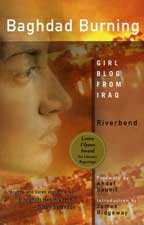 Most of us watch the news, read the paper or browse the Internet and consider ourselves up on the state of affairs in the Middle East. We banter over our lattes and wireless connections and think we understand it all. Riverbend’s Baghdad Burning: Girl Blog from Iraq shows us we understand very little. Even the most educated and constant news watchers have something to learn by reading this book. As a member of the United States Navy, I spent a year in the Middle East. I thought I had a good handle on what was going on. This book showed me a side of the story I never saw. Most of us watch the news, read the paper or browse the Internet and consider ourselves up on the state of affairs in the Middle East. We banter over our lattes and wireless connections and think we understand it all. Riverbend’s Baghdad Burning: Girl Blog from Iraq shows us we understand very little. Even the most educated and constant news watchers have something to learn by reading this book. As a member of the United States Navy, I spent a year in the Middle East. I thought I had a good handle on what was going on. This book showed me a side of the story I never saw.
Gripping and unique is the best way to describe this book. It gives you a peek inside a young Baghdad woman’s day-to-day life, starting in August 2003 and carrying through September 2004. Calling herself Riverbend, her blog style provides a very honest, stream-of-consciousness read, allowing me to feel the weight and the anxiety of impending raids as she describes them. I found myself laughing aloud with her quick wit and pulling my hair with the frustrations she describes.
From an emotional standpoint, this is not an easy read. As a member of the military, I approached this book fully supporting our mission in the Middle East, but the book does not speak highly of almost anything related to the United States. Due to this, I found myself wanting to stop reading several times simply because it made me uncomfortable. When I finished the book, I realized that this was what made the book so powerful. While I still hold my views very dear, Baghdad Burning forced me to evaluate these views. As with many situations, evaluating my perspective helps me understand them better and justify them more fully.
No matter what side of the political fence you stand on, Baghdad Burning will challenge your opinions and beliefs. Even if you completely disagree with everything Riverbend says, stick with the book. Even if you don’t change your mind about anything, you will finish this book more informed.
Keep an Internet connection handy while reading. It is a challenge to keep up on every person and event mentioned unless you are extremely familiar with the area’s history and geography. This doesn’t detract from the book, but inquiring minds will find they want to know more details about what Riverbend discusses. There is a whirlwind of names, dates and places and you can only get more out of the book by doing a little background research.
The one complaint I have about this book comes from the introductions. The passages chosen for the introductions, forewords and endorsements set the book in an immediate political category and there is no question where those politics stand. Riverbend has a definite political stance but it should be up to the reader to interpret on their own, and not have it imposed on them.
The best part of Baghdad Burning is it doesn’t end with the last page. As long as you can access the Internet, Riverbend’s blog is up and ready to read the latest update. You will find your fingers reaching for the keyboard every morning to see what Riverbend has to say. – Nicole Boalsback to top Imagine a Day
Sarah L. Thomson, Rob Gonsalves
Atheneum Books for Young Readers, 2005
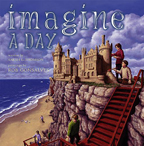 “Imagine a day…when a book swings open on silent hinges, and a place you’ve never seen before welcomes you home…Imagine a day…when grace and daring are all we need to build a bridge…Imagine a day…when you forget how to fall.” “Imagine a day…when a book swings open on silent hinges, and a place you’ve never seen before welcomes you home…Imagine a day…when grace and daring are all we need to build a bridge…Imagine a day…when you forget how to fall.”
Imagine a Day by Sarah L. Thomson is, essentially, a manual on dreaming big and believing that anything is possible. A beguiling invitation to straddle the line between the fantastic and the banal. Intrigued? Here’s the kicker: this slender little gem weighs in at a mere 33 pages – with a total count of just 246 words. It’s a children’s picture book. But please, don’t let the genre mislead you. Imagine a Day is a small but dense work of art and a deceptively simple ode to what can be.
Thomson’s simple poetic prose is made rich by layers of multifaceted meaning. The accompanying prints, by acclaimed Canadian painter Rob Gonsalves, are magical. Subtly surrealist depictions of the ever shifting, ever evolving realm of possibility, Gonsalves’ images actually stand alone. Informed by Thomson’s inspiring text, they breathe and enchant. Four hands, in tandem, weave a tangle of webs in which to get magically lost. And each time I pry open their pages, I find a new strand to scurry across.
Much like a child never gets sick of hearing her favourite bedtime story, I never tire of pondering Imagine’s imagery. Its magical text and illustrations seem always to be releasing new lessons, meanings and inspirations.
So while kids will no doubt be enthralled, what with all the new passageways in which to play “make-believe,” it is grown-ups who stand to discover this book’s deeper allure. Here, in our often play-less lives of routine, is some inspiration for a way to “make real.”
Imagine a Day is the second in what I can only hope will be a series of children’s picture books. Imagine a Night (by the same writer and illustrator team) was released in 2003. Thomson’s other books include The Dragon’s Son and Stars and Stripes. Gonsalves, a former architect, is a student of surrealism who has been making his living painting for over fifteen years. – Niki Andreback to top The Wisdom of Yoga: A Seeker’s Guide to Extraordinary Living
by Stephen Cope
Bantam, 2006, www.randomhouse.com/bantamdell
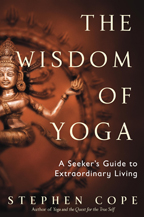 While yoga philosophy books can be dreary, erudite treatises, Stephen Cope’s The Wisdom of Yoga is an approachable – sometimes even conversational – guide to Patanjali’s classic Yoga Sutra. Though Patanjali’s sutras were probably developed for ancient ascetic yogis who would have differed from most contemporary yoga practitioners, Cope reveals how the sutras are still relevant for us, too. While yoga philosophy books can be dreary, erudite treatises, Stephen Cope’s The Wisdom of Yoga is an approachable – sometimes even conversational – guide to Patanjali’s classic Yoga Sutra. Though Patanjali’s sutras were probably developed for ancient ascetic yogis who would have differed from most contemporary yoga practitioners, Cope reveals how the sutras are still relevant for us, too.
The book’s backdrop is Massachusetts’ splendid Berkshire Mountains, where Cope is Senior Scholar in Residence at the Kripalu Center for Yoga and Health. Revealing an array of destructive life patterns through a narrative composed of fictionalized characters based on the author’s close friends, Cope’s psychotherapy training reveals itself as he prompts us to examine the patterns in our own lives with clear eyes. Indeed, to read this book thoroughly demands self-exploration; it’s not a theoretical romp through dusty philosophy but an exhortation to become fully ourselves and realize the genuine possibility of freedom. He offers himself as a guide on this path and provides useful frameworks for insight into our own restless psyches – what he calls the “Puppy Mind.”
The book entices with the fruits of practice such as states of meditative absorption, siddhis (supernormal powers available to the ardent practitioner) and samadhi (the state of oneness or integration, the final stage of the eight-limbed path). Cope also proves to be a spiritual guide who is able to let me into his own inconsistencies and foibles. For that, and for lucid insights into the power of friendship and spiritual community, The Wisdom of Yoga inspires while resisting easy answers.
The sobering point is driven home that to change our lives for the better, sometimes a teaspoon of good old-fashioned restraint (tapas) is more useful than a mountain of insight. Ironically, his book leads most easily to the development of insight – not concrete ways to change. The tools are there, but I’m not entirely sure how to use them.
The Wisdom of Yoga is mostly well thought out, with carefully constructed explanations of both the subtle meanings of Sanskrit words and the ineffable experiences on the yogic path. The transitions between the narrative, philosophical and scientific sections are occasionally rough and the dialogue and descriptions seem a little stilted – as if the author might prefer the aforementioned erudite treatise to storytelling. Nonetheless, the neurological evidence to back up yogis’ longstanding claims about the effects of meditation are welcome, as are the numerous parallels and divergences described between the yogic philosophy of Patanjali and Buddhism.
In the end the question remains: are Patanjali’s Yoga Sutras illuminated or are they still shrouded in esoteric sheaths of subtlety? My answer is that although there are undoubtedly many more layers to penetrate, The Wisdom of Yoga reveals bite-sized insights into an ancient text that can be chewed and digested by us modern seekers. – Danielle Brand-LeMondback to top Field Notes from a Catastrophe
Elizabeth Kolbert
Bloomsbury Press, 2006, www.bloomsbury.com
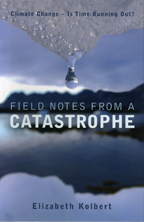 I knew global warming was bad. I knew that we needed to change. But like many of us, I didn’t know the specifics. In her new book, Field Notes from a Catastrophe, Elizabeth Kolbert balances an information deficit on the topic by providing a beautifully written, first-hand accounting of the situation. Without doubt, the author is a vital teacher in tenuous times. The expansive treatise on global warming, begun as a series of articles for the New Yorker, follows Kolbert around the world on a quest for information, examples and answers. I knew global warming was bad. I knew that we needed to change. But like many of us, I didn’t know the specifics. In her new book, Field Notes from a Catastrophe, Elizabeth Kolbert balances an information deficit on the topic by providing a beautifully written, first-hand accounting of the situation. Without doubt, the author is a vital teacher in tenuous times. The expansive treatise on global warming, begun as a series of articles for the New Yorker, follows Kolbert around the world on a quest for information, examples and answers.
In education lingo, she is adept at making content accessible. Given the breadth and scope of information presented, this is a formidable task. How does one explain that bit by bit, day by day, we are chipping away at the Earth’s ability to function as a sustainable atmosphere? Kolbert asks the right questions and takes us along for the ride. From Shishmaref, an Inuit village in Alaska whose land is receding, to the Cloud Forest in Costa Rica where the golden toad became extinct, she blends anecdote, observation and explanation to elucidate the phenomenon of global warming. Precise language and direct style only include technical terms where necessary, making the analysis both accessible and complete. But Kolbert does not shy away from complexities, such as a series of organic feedback loops that speed the warming process and climate reactions that could elicit floods and drought.
Perhaps most importantly, she makes us privy to experiences and responses through small but significant details of her travels. While at a research station in Greenland, she notices that snow under her tent is melting into a large puddle. She tries, but fails, to clean it up, concluding, “the puddle was too big, and eventually I gave up.” It is sad and frustrating. Poetic details like this one convey emotional resonance and humanize the problem.
In the second, longer portion of the book, Kolbert painstakingly lays out the hard realities of a civilization that is knowingly defeating itself. The carbon dioxide emissions resulting from cars, electricity, and even something as simple as turning on your coffee pot, accelerate the heating process. As an American, I read with a hard heart that we contribute 25 percent of carbon dioxide to the atmosphere. But harsh realities are tempered by potential solutions. We learn that mayors in the United States are banding together to try to meet or beat environmental standards, and several scientists discuss alternate energy sources. One of these, Robert Socolow, emphasizes that change is not a matter of practicality, but one of choice. Of the solutions he proposes, he says, “These things can all be done.”
Other species have altered the atmosphere, and other cultures have ended because of it. But Kolbert points out that “we are the first species to be in a position to understand what we are doing.” We only have one Earth. It isn’t disposable and we can’t afford to lose it. Yet every day, we are getting a little bit closer to doing just that. Will we choose to change before it’s too late? – Annie Buckleyback to top A Seat at the Table:
Huston Smith in Conversation with Native Americans on Religious Freedom
Huston Smith
University of California Press, 2006, www.ucpress.edu
 My own history included large family gatherings where children sat together, removed from the adult dining table. A time came when I was invited to take a seat with the “grown-ups.” It was a rite of passage, a validation that my voice had a place and would now be heard. My own history included large family gatherings where children sat together, removed from the adult dining table. A time came when I was invited to take a seat with the “grown-ups.” It was a rite of passage, a validation that my voice had a place and would now be heard.
In 1999, a delegation of nine Native Americans attended the Third Parliament of World Religions in Cape Town, South Africa. It was “to get a seat at the table with the recognized religions on the planet,” explained Walter Echo-Hawk, one of the delegates, “to make this gathering real and complete.” They determined that their voice would be heard. They explained the great paradox that has characterized their history of recent centuries: how a country founded on ideals of freedom of expression has denied religious and political freedom to its native people. Thus, the First Nations of the United States are still engaged in a struggle for an equal voice in the religious and political debates that hugely influence their destiny.
Huston Smith, renowned scholar of world religions and long-time advocate of Native American religious freedom, moderated the sessions at the Parliament and conducted follow-up interviews with all nine delegates, plus adding two more voices to the perspectives that emerged. A Seat at the Table offers the wisdom of these voices.
Their words are much more than a recount of injustice and historical wrongdoing. They offer understanding and insight into a way of being that is in profound contrast to that of the dominant world culture. Vine Deloria Jr., a Sioux elder and professor emeritus of history, begins the interviews and establishes a central theme that emerges through the following chapters: Native American spirituality is inextricably connected to the natural world. The whole universe is part of the community and must be represented in the spiritual ceremonies.
Winona LaDuke of the White Earth Reservation expands on the implications of this key element by pointing out that being a woodlands culture means you have to have a woodlands. A prairie culture needs a prairie. Sacred ceremony needs sacred space, but sacred space has been jeopardized, threatened, compromised, denied and expropriated for centuries. Thus, explains Lakota Charlotte Black Elk, the Native spiritual struggle is the battle for spiritual title to a cultural and religious tradition that includes land.
This is not just access to place, but also concerns the preservation of language. The web of life, explains Douglas George-Kanentiio of the Mohawk, is not only biological but also verbal; loss of language can trigger a spiritual crisis in a community.
As their voices explore the theme of connection and community, they return again and again to their responsibility to the generations that have gone before and to those of the future. From this emerges a sense of commitment to the teachings given by the Creator and passed on through the elders, which moulds ideals and purpose and which conveys an uplifting message.
Huston Smith commented at the conclusion of the interviews that he felt an inexplicable happiness after spending time with these delegates, something he did not experience at other religious forums. He notes that these voices “have a vision and a determination that inspires my own vision and determination.” Their place at the table is set. – Alanda Greeneback to top Deactivated West 100
by Don McKay
Gaspereau Press, 2005, www.gaspereau.com
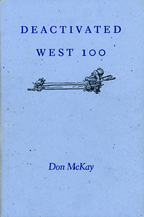 Wittgenstein once wrote, “Thinking is astonishment.” Don McKay’s second collection of essays, Deactivated West 100, exemplifies this truth. McKay is mostly known in this country as a poet and editor. Wittgenstein once wrote, “Thinking is astonishment.” Don McKay’s second collection of essays, Deactivated West 100, exemplifies this truth. McKay is mostly known in this country as a poet and editor.
Indeed, in the former capacity, McKay has exerted considerable influence on several generations of Canadian poets. As with his poetry, these essays give evidence of a deeply humble, humorous and passionate mind. His themes, however, are not light. Ecological crisis, and the capacity of our civilization to exploit and appropriate the natural world for short-sighted and destructive use, are here, as elsewhere in McKay’s work, at the forefront. These essays, however, are not embittered; they offer, rather, tentative proposals for what a more responsible and humble relationship to the world might look like.
A central theme McKay returns to is that of home, or more generally, place. According to McKay, when we consider the history of agrarian societies, we see that “the saga of place has involved colonization, agriculture, exploitation, land use, resourcism, and development, sustainable or otherwise.” This attitude is typified by the figure of Gilgamesh who desires to clear-cut the land in order to “set up his name.” McKay finds in this desire “the darkest element in our use of the land – the urge to lay waste … to make of our capacity for destruction an enduring sign and so achieve fame.” If not fame, then simply the preservation of our name on a gravestone, or of our soul in eternity, or of our history and memories in the stories we tell.
Some sign that we were here. It is the very human (and very understandable) desire to evade “oblivion,” complete loss – ashes scattered over the ocean – that is at the (psychological) root of human culture and the conquest of the natural world.
In one respect, it’s difficult to imagine how it could be otherwise. This is simply how it is with us: we use tools to make home, to make a place; we put a face on the nonhuman other with our stories and with our myths. But McKay is interested in standing imaginatively at the meeting site of the exchange between the human and the nonhuman world. He wants to contemplate the reverse of what has been our mostly one-sided relationship to the land. What can we learn about ourselves and our projects if we consider place “as a function of wilderness?…This would involve asking, for example, not ‘what’s the beach to me?’ but ‘what am I to the beach?’”
With these questions, McKay concerns himself with rocks, geological processes, the huge reach of “deep-time” – natural history as measured in millions rather than merely the 10,000 or so years of human history. The reader is asked to try to stretch her imagination that far. We are asked to slow down our thought to the speed of continental drift, and then consider our stories, our plots, our homes.
The result of these exercises is, for McKay, “geopoetry”: “those moments of pure wonder when we contemplate even the most basic elements of planetary dwelling, and our words fumble at attempts to do them justice.” And the result of geopoetry: nothing more spectacular than the softening of the heart, a tuning of the senses, a lessening of our desire for power over that which we cannot control. – Darren Biffordback to top
 “Spine upright and hips that make shade backbone of about eight bloodlines.” “Spine upright and hips that make shade backbone of about eight bloodlines.”
On her fourth album Anything, Kinnie Starr sings of lessons learned like blood running through her from teachers that hold her up like bones. In her “hip-hop meditations,” Starr’s savvy way of making teachers from all her relationships may be nothing less than “the healing of the nations.” She sings of the nations within her: all her territories defined and redefined, borders crossed and bounded, identities chanted and changing.
Comprised of melodies mending broken human connections, rhythms exploring conflict and resolution, Anything fills with lyrics and riffs articulating a divine inner strength. “The sky is the skin and the eyes are the stars,” she sings. “I live it all/ it’s just who I are.”
Dubbed “MC-singer-poet-actress-beatnik,” this multilingual, multidisciplinary, multi-ethnic, openly bisexual artist manifests the world that rhymes around her in a finely grooved internal rhythm.
With mixed-blood Mohawk roots and a musical heritage that ranges from LL Cool J to Led Zeppelin to Sade, Starr traverses more than just a few musical genres.
In “Blackbrown Eyes,” a hip-hop back beat and bass guitar accompanies a female voice intoning a traditional Mohawk chant.
That same voice weaves throughout the song – chanting, droning and whining – like layers of a story folded carefully and about to unfold. Partway through the song, a guitar riff accompanies the gentle backing vocal, the soft voice ends, and Starr starts, “Hey now, how’d it come this far?/ why don’t we know who we are?”
In “Rock the Boat,” deep male vocals incant an old Mohawk chant while a female R&B voice croons a modern version over and around the traditional one. The song unites diverse lessons from her blood and musical ancestors.
In “Walk Away,” a song about a love gone cold, she sings to “the moon [that] shines on the bay,” praying to it for strength. Even the moon here turns into her guru, its celestial teachings dispelling darkness, leading her to the Light that shines within her.
“I know it’s hard for you/ I’m such a willful girl,” she sings in “Please Hold My Hand.” “I know I push you away.” In one of her strongest moments on Anything, Starr’s music floats with a beautiful vulnerability. An acoustic guitar trips stepping and sinking in the harmony of water while a back beat keeps the tempo drumming on sand. Starr’s singing winds through and rises above the rhythm, as if her voice repeatedly falls in water and surfaces again. “I hear a river calling,” she sings, “and I can’t help but hearing/ it’s there for us to see/ our story’s up in trees.”
Whatever wars may have been waging with the nations inside of me before putting on Starr’s new album, after giving Anything a good listen, my territories reconciled, I disarmed to all the teachers in and around me and surrendered to some peace in Starr’s meditations. – Nancy Millerback to top
|
|